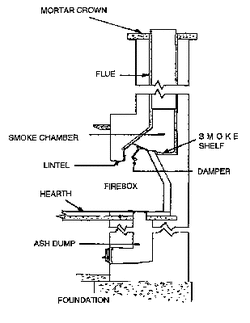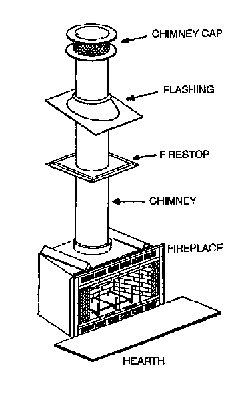When most people think of chimneys, they think of fireplaces. For thousands of years, humans have gathered around the open fire for a sense of safety and community, and the fireplace is still the focus of family living in many homes, especially around the holidays.
But in spite of all the glowing aesthetics, there are some practical considerations. When you’re dealing with an element as dangerous as fire, knowledge is power. Please read on to learn how to make your fireplace both safer and more enjoyable.
Let’s start with a quick anatomy lesson, and a brief explanation of common terms:
Fireplaces come in two general types: masonry fireplaces and factory built (prefab) fireplaces. To figure out which you have will take only a moment of detective work on your part. A masonry fireplace has a firebox built of individual generally yellowish firebrick, a brick chimney above the roof, and if you look up past the damper you will see a roughly pyramid shaped affair also built of brick. A prefab fireplace generally has a firebox of cast refractory panels, and usually some metal is visible in the room all around the firebox. If you look up past the damper, you will see a round metal chimney. And above the roof is more round metal chimney, sometimes surrounded by a simulated brick housing.
Although similar, there are some important differences which we discuss below.
MASONRY FIREPLACES – Some Special Considerations
Masonry fireplaces, built of bricks, blocks or stone and mortar, are massive structures often weighing between 6 and 7 tons! They are aesthetically pleasing, long lasting, and add real value to your home. With a little care and periodic maintenance they can give you a lifetime of enjoyment.
Masonry fireplaces require an extensive footing for support or they will often shift and crack, allowing the fire to escape to nearby combustibles. You should always keep an eye out for any signs of settling or movement. Inside the firebox, where the facing material meets the firebrick, is one weak spot where this settling often first appears. You can keep settling problems to a minimum by directing downspouts away from the fireplace and by sloping the ground around the fireplace so that water runs away from the structure
Although masonry is quite durable, and in fact is often seen as indestructible, this is not the case, especially for chimneys. While the rest of the brick on the house receives some protection from the eave, the chimney is vulnerable to every raindrop and freeze/thaw cycle. A quality chimney cover, keeping the crown in good repair, and a waterproofing treatment, are great ways to avoid expensive repairs or rebuilding. See the section on waterproofing for a more detailed explanation.
The firebox of course takes the brunt of the fire’s heat and it requires some special attention. The firebrick can take the heat pretty well, but over time the joints will fail from the constant expansion and contraction. In addition, refractory mortar is specified and seldom used. In a fireplace without a chimney cover, the rain water will pool on the smoke shelf, mix with the soot behind the damper, and form an acidic slurry that can destroy the mortar joints. Keeping these joints in good repair with a high temperature refractory mortar will help ensure the fire is contained.
The tile liners used in most masonry fireplaces are fine as long as the fireplace is properly maintained and not exposed to chimney fires. One good chimney fire will usually crack these tiles, rendering them ineffective. The general rule of thumb is that a masonry fireplace should be swept before 1/8″ of soot accumulates. If you experience a chimney fire, it is very important to have the chimney swept and inspected before you use it again. Check out our information on Chimney Fires and Liners for further information.
Unlike prefabricated fireplaces, a masonry fireplace is built on site brick by brick, giving the mason ultimate control of the final product. This results in a wide range of masonry fireplaces available. With proper care and maintenance, Most masonry fireplaces can provide you with many peaceful, relaxing hours.

Prefabricated Fireplaces
Factory built, or prefabricated fireplaces, are relative newcomers to the fireplace scene. Unlike traditional masonry fireplaces, most factory built fireplaces are metal, and come from the factory as complete units with a firebox, a specific chimney system, and all miscellaneous parts. With proper installation and maintenance, they can give years of service, but there are some special considerations:
- The factory-built fireplace and chimney are a complete system, engineered to work together. Both units (fireplace and chimney), undergo testing together, then are listed specifically for use with each other.
- The installation instructions must be followed exactly, especially the specified clearances from the firebox and chimney to any combustible materials. Most manufacturers require no less than 2″ of air space between the chimney components and all wood framing. If you are installing a new unit be sure you strictly adhere to these clearance instructions. If you already have a unit installed it is very important you check these clearances wherever possible. Any wood that is too close to the chimney will undergo a process called pyrolysis and even catch fire at temperatures as low as 200 degrees. Most of the units inspected by chimney professionals are improperly installed, and a trip to the attic to check clearances is definitely time well spent! Inspecting the firebox clearances is more challenging.
- Most factory built fireplaces are tested and listed as decorative heating appliances and will not withstand excessively heavy use. Although they are tested to U.L. standards, severe over-firing and chimney fires will often badly damage these units. Regular yearly maintenance and careful monitoring can assure a safe enjoyable system.
- Many prefab chimneys, especially older units with an imitation brick housing above the roof, seem to be a preferred nesting site for birds in many areas. It is not unusual for chimney sweeps to remove buckets of nesting material from these chimneys. This nesting can catch fire or block critical air passageways between layers of metal chimney pipe, causing the chimney to overheat. Both scenarios routinely cause house fires. Most aftermarket chimney covers are insufficient and can often make the problem worse. A careful screening of all potential nesting areas with the proper sized screening may be in order.
- Finally, prefab fireplace systems eventually wear out. Models go out of production and manufacturers go out of business. Keep a close eye on an aging unit, and be prepared to send ole faithful to the great recycling plant in the sky before she fails completely.

Information from CSIA website